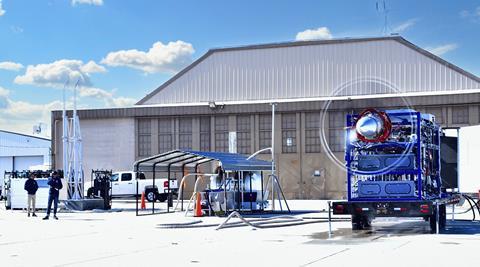Universal Hydrogen has run its hydrogen-fuel-cell propulsion system on hydrogen supplied from one of its proprietary storage tanks, a milestone the company says helps demonstrate the feasibility of its hydrogen-powered regional aircraft concept.
“This end-to-end demonstration of a hydrogen molecule moving from our filler/dispenser into our storage module and then into our powertrain is the first time that all the pieces of our product portfolio for regional aviation have come together,” says Universal chief executive Paul Eremenko.
The Hawthorne, California-based company has already test flown a modified De Havilland Canada Dash 8 aircraft powered partly by a hydrogen-fuel-cell powerplant. But that set up involved “stationary gaseous hydrogen” tanks.

Only now has the start-up run its fuel-cell powerplant on hydrogen stored in and supplied by one of its liquid-hydrogen tanks, which Universal calls “modules”. It says the modules will be easy to transport and to swap on and off aircraft, allowing for quick fueling.
Universal “has successfully run a megawatt-class fuel-cell powertrain using its propriety liquid-hydrogen module to supply fuel”, it says on 27 February. Fuel cells use liquid hydrogen and air to produce electricity.
During the test, conducted at the Mojave Air & Space Port in the California desert, the powerplant was strapped to a ground-test rig called an “iron bird”. Universal ran the system, with fuel provided from a module, for 1h 40min – a typical regional-aircraft flight duration, it says.
“The company’s liquid-hydrogen module holds fuel to power the iron bird for over 3h at full power, with two such modules sufficient for 500nm of usable range (on top of reserves) for an ATR 72 regional airliner,” Universal adds.
The company is developing hydrogen-fuel-cell propulsion conversions for both Dash 8s and ATR turboprops. It expects its ATR retrofit will be available first.
The ground tests involved a powertrain similar to the system Universal installed on its Dash 8 test aircraft, which first flew in March 2023. That powertrain replaced the Dash 8’s right-side Pratt & Whitney PW123 turboprop. It consisted of a fuel-cell system, supplied by New York company Plug Power, feeding electric power to a Magnix-made 872hp (650kW) Magni650 electric motor, which turned the prop.

Hydrogen storage challenges are among the many hurdles facing developers of hydrogen-powered aircraft. Several designs under development use liquid hydrogen, which must be kept colder than -253°C (-423°F) to remain liquid.
That is why Universal is developing specialised storage modules capable of holding 200kg (441lb) of liquid hydrogen.
“The module contains systems to convert cryogenic liquid hydrogen into warm gaseous hydrogen that is consumed by the powertrain,” Universal says. “The liquid hydrogen module… internalises all the complexity of managing cryogenic hydrogen, while externally presenting a simple container interface compatible with existing intermodal freight and airport cargo handling equipment.”
It is developing the modules at its site in Toulouse, France.


























